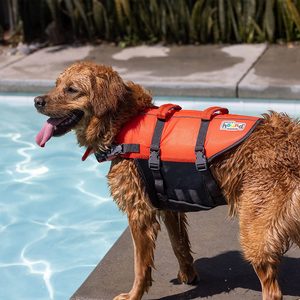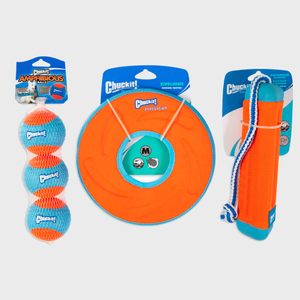Can All Dogs Swim? What to Know Before Taking Your Pup for a Dip
Updated: May 15, 2023
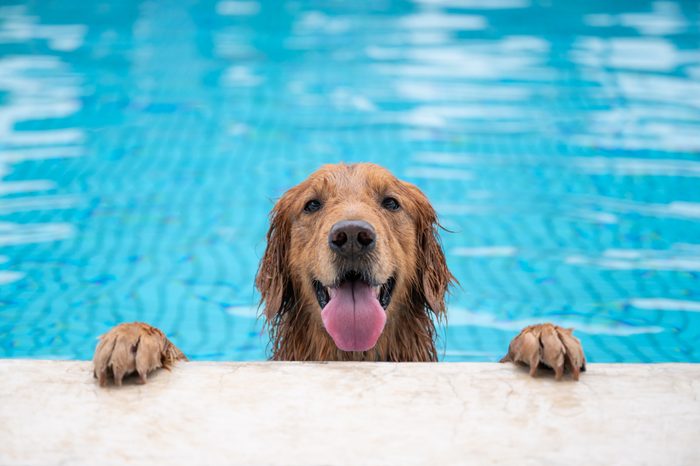
Our editors and experts handpick every product we feature. We may earn a commission from your purchases.
Summer brings all sorts of outdoorsy fun, from barbecues to ice-cream nights, but one of the best parts is heading to the lake, pool or beach. Of course, you don’t want your furry BFF to miss out on all the fun, especially if you’ve rented a beach house, but should you draw the line at water activities? If you’ve never taken your pup in the water or to a dog-friendly beach, you might wonder if this is safe. Yes, the doggy paddle was named after the adorable way dogs move through the water, but can all dogs swim?
Certainly, it’s one of the things dogs wish you knew—right behind whether dogs can eat ice cream and hot dogs! We have the answers to ensure your summer activities are fun and safe for your pup.
Get Reader’s Digest’s Read Up newsletter for more pet insights, humor, cleaning, travel, tech and fun facts all week long.
Do dogs like to swim?
That depends. “Some dogs like to swim on their own, as they enjoy the water,” says Amber Karwacki, DVM, a veterinarian at Heart+Paw. Other dogs might follow you into the water even if they don’t like it for the sheer enjoyment of being next to you. And if that doesn’t pull at your heartstrings, this will: Some loyal dog breeds overcome their aversion to water because they think you’re in danger. “If your dog is protective, they will do things they normally would not to keep you safe,” says Dr. Karwacki.
Can all dogs swim?
It’s impossible not to associate the doggy paddle with dogs swimming. After all, that’s where we get the basic swimming technique from. Yet not all dogs can swim. Some don’t have the desire to be in or near the water, while other breeds might find swimming difficult or impossible. “These include any of the brachycephalic, or ‘smushed nose’ breeds, and dogs with long bodies and short legs such as corgis, dachshunds and basset hounds,” says veterinarian Kelly Diehl, DVM, senior director of science communication at the Morris Animal Foundation.
The good news is that dogs without natural swimming instincts can be taught with lessons, and you can keep them safe by putting them in a doggy life jacket. But can all dogs swim if they have swimming lessons? If your pup isn’t showing any interest or appears anxious in or around water, it might be better to stay on dry land.
Which dogs are natural swimmers?
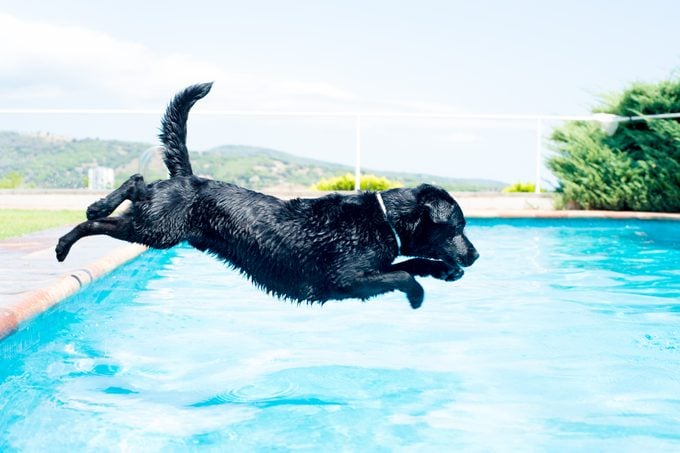
Several dog breeds are inherently drawn to water. “They tend to be breeds that were bred to work in and around water,” says Dr. Diehl. If these top-notch swimmers had résumés, their roles would span from heroic water rescues to hunting and retrieving to working with humans in and around boats. Still, genetic makeup isn’t a guarantee. Some descendants of well-known water-loving breeds may never want to dip their paws in for one reason or another. That said, the most common dog breeds known for swimming include:
- Labrador retriever
- Chesapeake Bay retriever
- Newfoundland
- Standard poodle
- Golden retriever
- Portuguese water dog
- Otterhound
- Spanish water dog
- English setter
- Irish water spaniel
- American water spaniel
- Barbet
- Boykin spaniel
- Curly-coated retriever
- Flat-coated retriever
- Lagotto Romagnolo
- Nova Scotia duck tolling retriever
Which dogs can’t swim?
Certain breeds simply can’t doggy paddle like others due to their physical characteristics. “Dogs with shorter legs like dachshunds, rounder chests like pugs or denser muscle mass like bull terriers cannot swim,” says Dr. Karwacki. Shorter legs, long bodies or barrel-shaped bodies struggle with staying afloat. And flat-faced breeds, like pugs, can easily get water up their noses and struggle to breathe, especially while exerting themselves swimming.
Other issues? The thick and dense coats some dogs sport aren’t waterproof or water-repellent, so they get heavy in the water. And generally, most toy dog breeds, bred to be affectionate and cuddly, tend to favor a cozy lap over swimming laps.
Here are some of the breeds that prefer a belly rub to a belly flop:
- Pug
- Dachshund
- Bull terrier
- Bassett hound
- French bulldog
- Boxer
- Pekingese
- Corgi
- Shih Tzu
- Chow chow
- Sharpei
- Staffordshire bull terrier
How do you know if a dog can swim?
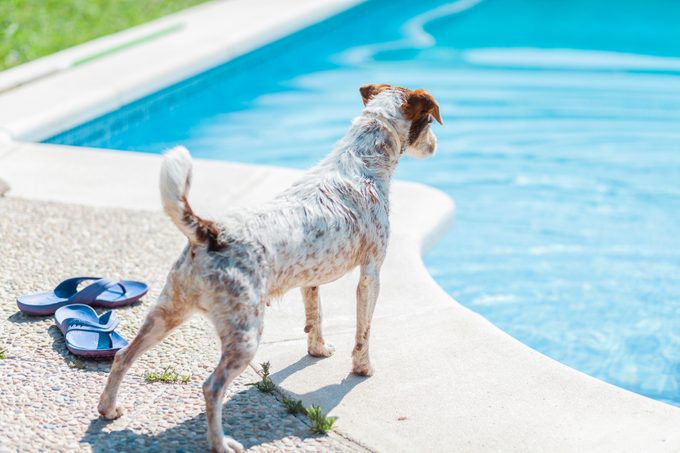
OK, now you know how to answer the question: Can all dogs swim? But how do you know if your dog can swim? Regardless of whether you have a water-loving dog, a cute mixed breed or a super mutt, the first step is figuring out if your pup has any interest in playing or swimming in the water. “Walk around shallow water, wade in a little and see if they follow,” says Dr. Diehl. If they’re not interested, invite some doggy friends to join or hit up a dog park with a designated swim area for pups. “One of my own Labrador retrievers was not enthusiastic but fell right in with the crowd when she saw other dogs swimming,” Dr. Diehl adds.
Once they are in a depth of water where paddling is necessary, watch them closely. Dogs instinctively know how to dog paddle, but dogs with little or no experience panic and frantically splash around to stay afloat. Dogs that propel their paws outward and back down, pushing the body in a smooth forward motion, show they can swim beyond panic/survival mode. With frequent and consistent swim sessions, pups can learn to swim safely and comfortably.
How to teach your dog to swim
First and foremost, “never toss your dog into the water to force them to swim,” says Dr. Diehl. Your sweet pup will likely panic and be scarred for life, never wanting to return for a second lesson. Sarah-Anne Reed, a consulting holistic dog trainer at Healthy Paws Pet Insurance and owner of Pack Dynamics in Bend, Oregon, shares the following steps for teaching your dog to swim.
Test the water
Select a calm and shallow area with a gradual slope. Ensure the area is free of sharp rocks, broken glass and the like. “The water should be cool but not frigid,” says Reed, “and outside temperatures should be at least 50 degrees.”
A doggy or kiddie pool is another great way to introduce puppies to water. “Begin with a small amount of water, and put some favorite toys in the pool,” Reed advises. “Move to deeper bodies of water only when your pup is comfortable not touching the ground.”
Use a life vest
Like humans, dogs need a life vest to keep them afloat while learning to swim. Choose a doggy life vest with a handle to grab them easily when in the water. Your dog might not share your enthusiasm for wearing a vest, so hold off on the first swimming lesson until they get acclimated to it. “Help your dog feel comfortable wearing the life vest by putting it on them every day, starting with five minutes and gradually increasing the time, before taking them to swim,” says Reed.
After your pup has mastered swimming, it’s still a smart idea to use the vest to keep them safe. It can be a literal lifesaver if your dog gets tangled up in seaweed or debris or ends up in unpredictable currents.
Introduce your dog to the water gradually
Let your dog sniff around the water, and give them time to ease into it, wading up to their ankles. “Dogs will naturally feel more comfortable if they can touch the ground with their feet as they adjust to the sensation of being in water,” says Reed. Then, slowly encourage them to venture a little deeper. “Use positive reinforcement, such as treats and praise, to reward your dog for their progress.”
Show your dog how to swim
Since most dogs want to be with you, doing whatever you’re doing, use that to your advantage and get into the water with them—as long as you know how to swim. If your dog is scared, grab the handle on the vest and hold them close. “Once they seem comfortable in the water, swim around in front of your dog and encourage them to follow you,” says Reed. “This is easier if one person is holding your dog, while the other is gently coaxing them to swim.”
Dog water toys and balls are great ways to entice your dog to stay in the water and swim. Toss one just a few feet at first, and then gradually increase the throwing distance when your dog gets more confident.
Stay close and monitor your dog
Your dog is depending on you to be their personal lifeguard while they are in and around the water. “Keep an eye on their body language and behavior, and be ready to help them if they need it. Some dogs might not realize their limit, especially puppies or dogs swimming together who are having a grand ol’ time in the water. “If your dog becomes tired and is struggling to swim or panting excessively, take a break, and try again another day,” says Reed.
Rinse off your dog after swimming
“After your dog’s swim, rinse them off with fresh water to remove any chlorine or salt from their coat,” says Reed. This will help prevent skin irritation and the possibility of toxic ingestion when dogs lick their wet fur.
The best products for swimming with your dog
Other safety issues to watch out for
Ready for a dip? Wait! Keeping your dog safe in the water isn’t simply a matter of keeping them afloat. Here are some other things to keep in mind:
Harmful algae
“With the climate warming, we’re seeing a lot more cases of blue-green algae poisoning,” says Dr. Diehl. Seen in freshwater, this bluish-green algae can smell like rotting garbage. Avoid any water that clearly has pond scum and smells. When a dog drinks this contaminated water or licks its fur after swimming, it can work quickly.
Warning signs your dog is sick include abdominal pain, vomiting, diarrhea, weakness, staggering, disorientation and seizures within hours of exposure or up to a few days after ingesting, Dr. Diehl says. If you suspect your dog was in blue-algae water, call your veterinarian immediately.
Dangerous water conditions
Many dogs are stellar swimmers, but even the Michael Phelps of the canine world can get caught off-guard in certain conditions. “Dog owners still need to be mindful of rough weather, large waves, air temperature and water temperature,” says Dr. Diehl.
Hazards in the water
Whether you’re heading into the lake or a pool, scope the area for potential hazards. “Ensure there is a safe entry and exit point,” says Dr. Karwacki. Seeing every danger in the water is impossible, but you should still look for broken glass, sharp shells and dead tree limbs under the surface that could trap your dog. If your dog doesn’t object, try getting them used to wearing paw protectors to shield their paws from sharp objects and hot sand that can burn their paw pads.
Deeper-than-expected water
“Dogs can charge into the water and suddenly find themselves in over their head,” says Dr. Diehl. This happened to one of her neighbor’s dogs that was used to swimming in shallow water. “She decided to follow our Labrador into a pond near our house but started panicking when she found herself suddenly in deeper water, and we had to wade in and help her out.” Dogs may not have good judgment about how far or deep they should go, so always be present when your dog is swimming.
Sources:
- Amber Karwacki, DVM, veterinarian at Heart+Paw
- Kelly Diehl, DVM, veterinarian and senior director of science communication at Morris Animal Foundation
- Sarah-Anne Reed, consulting holistic dog trainer at Healthy Paws Pet Insurance and the owner of Pack Dynamics in Bend, Oregon

